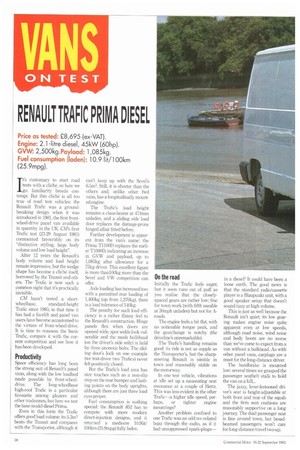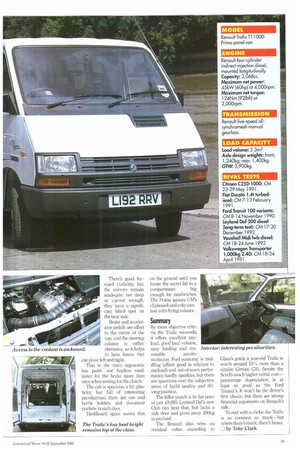RENAULT TRAFIC PRIMA DIESEL
Page 40

Page 41

If you've noticed an error in this article please click here to report it so we can fix it.
It's customary to start road tests with a cliche, so here we go: familiarity breeds contempt. But this cliché is all too true of road test vehicles: the Renault Trafic was a groundbreaking design when it was introduced in 1981, the first frontwheel-drive panel van available in quantity in the UK. CMs first Trafic test (23-29 August 1981) commented favourably on its "distinctive styling, large body volume and low load height".
After 12 years the Renault's body volume and load height remain impressive, but the wedge shape has become a cliche itself, borrowed by the Transit and others. The Trafic is now such a common sight that it's practically invisible.
CM hasn't tested a short wheelbase, standard-height Trafic since 1985; in that time it has had a facelift and panel van users have become accustomed to the virtues of front-wheel-drive. It is time to reassess the basic Trafic, compare it with the current competition and see how it has been developed.
Space efficiency has long been the strong suit of Renault's panel vans, along with the low loadbed made possible by front-wheeldrive. The long-wheelbase high-roof Trafic is a particular favourite among glaziers and other tradesmen, but here we test the base model diesel Prima.
Even in this form the Trafic offers good load volume: its 5.3m3 beats the Transit and compares with the Transporter, although it can't keep up with the Severs 6.5m3. Still, it is shorter than the others and, unlike other fwd vans, has a longitudinally mounted engine.
The Trafic's load height remains a class-beater at 474mm unladen, and a sliding side load door replaces the damage-prone hinged affair fitted before.
Further development is apparent from the van's name: the Prima T1100D replaces the earlier T1000D, indicating an increase in GVW and payload, up to 1,085kg after allowance for a 75kg driver. This excellent figure is more than100kg more than the Sevel and VW competition can offer.
Axle loading has increased too: with a permitted rear loading of 1,400kg (up from 1,270kg), there is a load tolerance of 140kg.
The penalty for such load efficiency is a rather flimsy feel to the Renault's construction. Hinge panels flex when doors are opened wide, spot welds look vulnerable and the mesh bulkhead (on the driver's side only) is held by three anorexic bolts. The sliding door's lock on one example (we test-drove two Trafics) never felt positively closed.
But the Trafic's load area has nice touches such as a non-slip step on the rear bumper and lashing points on the body uprights, although there are just three load eyes proper.
Fuel consumption is nothing special: the Renault 852 has to compete with more modern direct-injection designs, and it returned a mediocre 10.91it/ 100km (25.9mpg) fully laden. Initially the Trafic feels eager, but it soon runs out of puff as you realise that the closelyspaced gears are rather low; fine for town work (with fifth useable at 30mph unladen) but not for Aroads.
The engine feels a bit flat, with no noticeable torque peak, and the gearchange is notchy (the driveline's unremarkable).
The Trafic's handling remains good: its ride is not as supple as the Transporter's, but the sharpsteering Renault is nimble in town and reasonably stable on the motorway.
In one test vehicle, vibrations at idle set up a nauseating seat resonance at a couple of Hertz. This was less evident in the other Trafic—a higher idle speed, perhaps, or tighter engine mountings?
Another problem confined to one Trafic was an odd rev-related buzz through the radio, as if it had unsuppressed spark-plugs
in a diesel? It could have been a loose earth. The good news is that the standard radio/cassette player is a Blaupunkt unit, with a good speaker setup that doesn't sound tizzy at high volume.
This is just as well because the Renault isn't quiet; its low gearing makes engine noise quite apparent even at low speeds, although road noise, wind noise and body boom are no worse than we've come to expect from a van without a bulkhead. As with other panel vans, earplugs are a must for the long-distance driver.
The handbrake is mounted low: several times we grasped the passenger seatbelt stalk to hold the van on a The jazzy, lever-festooned driver's seat is height-adjustable at both front and rear of the squab and the firm seat cushions are reasonably supportive on a long journey. The dual passenger seat is fine around town, but broadbeamed passengers won't care for long-distance travel two-up. There's good forward visibility, but the mirrors remain inadeqate: not deep or curved enough, they leave a significant blind spot on the near side.
Brake and accelerator pedals are offset to the centre of the van, and the steering column is rather obtrusive, so it helps to have knees that can pivot left and right.
This is the van's ergonomic low point—our hapless roadtester hit the brake more than once when aiming for the clutch.
The cab is spacious, a bit plasficky, but full of interesting peculiarities: there are can and bottle holders and document pockets in each door.
Dashboard space seems thin on the ground until you locate the secret lid to a compartment big enough for sandwiches. The Prima passes afs clipboard-and-coke-can test with flying colours.
By most objective criteria the Trafic succeeds, it offers excellent payload, good load volume,
easy loading and reaIntern)
sonable accom modation. Fuel economy is middling (albeit good in relation to payload) and out-of-town performance hardly sparkles, but there are questions over the subjective areas of build quality and driving position.
The killer punch is its list price of just £8,695: Leyland Daf's new Club can beat that, but lacks a side door and gives away 200kg in payload.
The Renault also wins on residual value: according to Glass's guide a year-old Trafic is worth around 10% more than a similar Citroen C25, despite the Severs much higher initial cost— percentage depreciation is at least as good as the Ford Transit's. It won't be the driver's first choice, but there are strong financial arguments on Renault's side.
To end with a cliche: the Trafic is as common as muck—but where there's muck, there's brass.
by Toby Clark


























































































